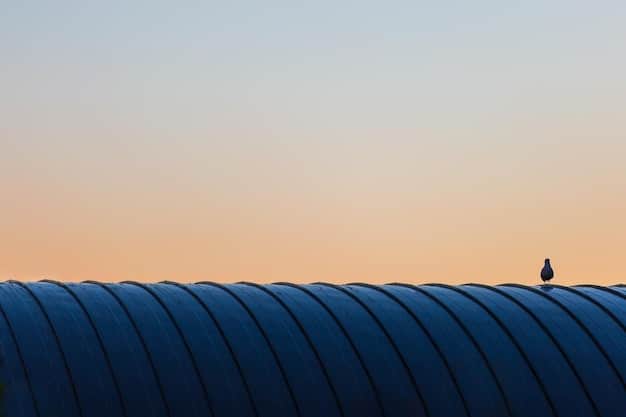Solar Water Heating: Heat Your Water with Sun & Save Costs

Harnessing the sun’s energy for water heating fundamentally transforms household energy consumption, offering a sustainable and cost-effective alternative to conventional methods by significantly reducing utility bills and carbon footprints through the direct use of a renewable resource.
In an era where energy efficiency and sustainability are paramount, the concept of heating your home’s water using the sun’s abundant power is not just an eco-conscious choice, but a financially savvy one. Solar water heating: Heat your water with the sun and save on energy costs offers a compelling solution, moving beyond simple advocacy to tangible household benefits and environmental stewardship.
The Basics of Solar Water Heating Systems
Understanding how solar water heating works is the first step towards appreciating its efficiency and environmental benefits. At its core, these systems capture solar radiation to heat water, which is then stored for later use in your home. This technology leverages fundamental principles of thermodynamics, converting sunlight into usable heat energy.
Unlike photovoltaic (PV) solar panels that generate electricity, solar water heaters (also known as solar thermal systems) directly heat water. This direct conversion makes them incredibly efficient for this specific purpose. The systems typically consist of solar collectors, an insulated storage tank, and a circulation system to move the heat transfer fluid or water through the collectors and into the tank.
Types of Solar Collectors
The type of solar collector installed is a critical decision, as it dictates efficiency and suitability for different climates. Each design offers distinct advantages based on factors like weather conditions, space availability, and budget.
- Flat-plate collectors: These are the most common type, resembling skylights. They consist of a dark absorber plate in an insulated box with a clear glass or plastic cover. Sunlight passes through the cover and hits the absorber plate, which then heats the fluid passing through tubes attached to the plate.
- Evacuated tube collectors: These are more efficient, especially in colder climates or when higher temperatures are needed. They are made of parallel rows of transparent glass tubes, each containing a dark absorber fin sealed in a vacuum. The vacuum significantly reduces heat loss, making them highly effective.
- Integral collector-storage (ICS) systems: Also known as batch heaters, these are simpler systems where water is heated directly in a large, black tank or tubes within an insulated box. They are often less efficient but more affordable, best suited for areas with significant sunlight and mild winters.
Each collector type is designed to optimize heat absorption and retention under various environmental conditions. Choosing the right one ensures maximum energy savings and system longevity.
The collectors are usually mounted on a south-facing roof to maximize exposure to the sun. Once the water (or heat transfer fluid) is heated, it’s circulated to an insulated storage tank. This tank is crucial as it holds the heated water until it’s needed, much like a conventional water heater but without the constant need for electricity or gas to maintain temperature.
Understanding these basic components and their functions sets the stage for a deeper dive into the array of benefits and considerations involved in adopting solar water heating technology.
How Solar Water Heaters Work: A Deep Dive into Technology
The operation of solar water heating systems, while seemingly complex, relies on straightforward principles of heat transfer. The efficiency and reliability of these systems stem from their intelligent design, which encompasses fluid dynamics, insulation, and responsive control mechanisms. They are engineering marvels that transform ambient solar energy into a practical utility.
Solar water heaters primarily fall into two categories: active and passive systems. Each type employs different methods for circulating water or heat transfer fluid and has distinct operational characteristics.
Active Solar Water Heating Systems
Active systems are characterized by their use of pumps and controls to circulate fluids. This active management allows for greater control over water temperature and is generally more efficient for larger households or those with significant hot water demand.
- Direct circulation systems: These systems pump household water directly through the collectors, where it’s heated by the sun. The heated water then flows into the storage tank. They are typically best suited for climates where temperatures rarely drop below freezing. Simplicity is their strength, offering direct heating and often lower initial costs.
- Indirect circulation systems: Here, a non-freezing heat-transfer fluid (like propylene glycol) circulates through the collectors and transfers heat to the potable water in the storage tank via a heat exchanger. These systems are ideal for climates with freezing temperatures, as the heat-transfer fluid protects the system from damage. This design offers durability and performance in diverse weather.
The pumps in active systems are often powered by a small photovoltaic panel, making the entire operation more self-sufficient and reducing reliance on grid electricity. Controllers monitor temperatures in the collectors and the storage tank, activating the pump only when there’s enough solar energy to heat the water further, optimizing energy use and preventing overheating.
Passive Solar Water Heating Systems
Passive systems, on the other hand, do not use pumps or controls. They rely on natural convection and gravity for fluid circulation, making them simpler, less expensive, and generally more reliable with minimal maintenance. Their efficiency can be lower than active systems but their fundamental simplicity makes them appealing for many.
- Integral collector-storage (ICS) passive systems: These systems combine the collector and storage tank into a single unit. Water enters the bottom of the unit, heats up as it rises, and then moves to the top, where it’s drawn off for use. They are usually pre-heaters, meaning they warm the water before it enters a conventional water heater.
- Thermosiphon systems: These rely on the natural tendency of hot water to rise. The storage tank is placed above the collector, and as water in the collector heats up, it becomes less dense and rises into the tank. Cooler water from the tank flows down to the collector to be heated, creating a continuous circulation loop without the need for pumps.
While passive systems are simpler and less prone to mechanical failure, their performance can be more sensitive to outdoor temperatures and solar availability. They are typically most effective in warmer climates with consistent sunshine.
Regardless of the type, an important component of any solar water heating system is the backup heating element. This ensures that you have hot water even during periods of low solar availability, such as cloudy days or during nighttime. This backup can be an electric element or a connection to a gas water heater, integrating seamlessly with your existing infrastructure.
The detailed understanding of these systems highlights their technological sophistication aimed at maximizing solar gain and minimizing energy consumption. This robust engineering ensures that solar thermal solutions are a practical and powerful tool in sustainable living.
Environmental and Economic Benefits of Solar Water Heating
The decision to switch to solar water heating: heathen your water with the sun and save on energy costs extends far beyond personal convenience, encompassing significant environmental stewardship and substantial economic advantages. These systems are not merely an alternative but a superior choice for a sustainable and economically sound future.

From an environmental perspective, solar water heaters dramatically reduce your carbon footprint. Heating water is typically the second largest energy consumer in a household after space heating and cooling. By displacing electricity generated from fossil fuels or direct burning of natural gas, solar thermal systems prevent the release of tons of greenhouse gases into the atmosphere annually.
The environmental benefits include:
- Reduced greenhouse gas emissions: Utilizing solar energy directly means less reliance on fossil fuels, leading to a substantial decrease in CO2 and other harmful emissions. This directly contributes to combating climate change and improving air quality.
- Conservation of natural resources: Unlike finite fossil fuels, solar energy is an inexhaustible resource. Harnessing it for daily needs ensures that valuable non-renewable resources are preserved for future generations.
- Lower demand on the electrical grid: During peak demand times, solar water heaters reduce the stress on the utility grid, potentially delaying the need for new power plants and transmission lines, which often carry their own environmental burdens.
Beyond the environmental imperatives, the economic advantages are perhaps the most immediate and tangible for homeowners. The primary financial benefit stems from significant reductions in monthly utility bills. Once installed, the “fuel” for solar water heating—sunlight—is entirely free. This translates into substantial savings over the lifespan of the system, which can be 20 years or more.
Economic benefits include:
- Significant savings on energy bills: Hot water typically accounts for 15-25% of a household’s energy consumption. Solar water heaters can offset 50-80% of this demand, leading to hundreds or even thousands of dollars in savings annually.
- Long-term investment and increased property value: Installing a solar water heating system is an investment that enhances the value of your property. Homes with renewable energy systems are often more attractive to potential buyers, commanding higher resale values.
- Access to incentives and rebates: Many governments at federal, state, and local levels offer tax credits, rebates, and grants for installing solar thermal systems. These incentives can significantly reduce the initial upfront cost, shortening the payback period and making the investment even more appealing. For instance, the U.S. federal solar tax credit (Investment Tax Credit – ITC) has historically offered a percentage of the cost of the system as a credit against federal taxes.
The combination of environmental responsibility and economic prudence makes solar water heating an increasingly attractive option for homeowners mindful of both their budget and their ecological footprint. These systems empower individuals to take direct action against rising energy costs and climate change, fostering energy independence and promoting a cleaner, healthier planet for everyone. The initial investment is recouped over time through continued savings, making it a wise long-term financial decision.
Considering Installation: Factors and Site Assessment
Before committing to solar water heating: heat your water with the sun and save on energy costs, a thorough assessment of your specific situation is crucial. Proper planning and understanding the factors influencing installation success will ensure the system performs optimally and delivers the expected savings and environmental benefits. This phase is critical for system sizing and placement.
Key Factors Influencing System Performance
Several variables must be considered to maximize the efficiency and cost-effectiveness of a solar water heating system. These factors directly impact the amount of solar energy available for heating and the overall system design.
- Solar resource availability: The amount of sunshine your location receives is paramount. Southern states in the US generally have excellent solar resources, but even colder, sunnier climates can benefit significantly. Local solar insolation maps can provide detailed data for your specific area.
- Roof orientation and tilt: For most of the Northern Hemisphere, collectors should ideally face true south (or slightly southwest) to capture the most sunlight throughout the day. The tilt of the collectors should ideally match your latitude for year-round performance, or be adjusted for seasonal optimization if heating needs vary significantly.
- Shading: Any obstructions that cast shadows on the collectors, such as trees, chimneys, or neighboring buildings, can severely reduce system efficiency. A site assessment should identify and quantify any potential shading issues throughout the year.
Beyond these environmental factors, your household’s hot water demand plays a significant role in determining the appropriate size of the system. An undersized system won’t meet your needs, while an oversized one can be an unnecessary expense and lead to overheating issues. Factors like the number of occupants, daily hot water usage patterns, and the presence of high-demand appliances (like dishwashers and washing machines) should be accurately estimated.
The Importance of Professional Site Assessment and Installation
While some aspects of solar water heating might seem straightforward, a professional site assessment and installation are highly recommended. Certified solar professionals possess the expertise to evaluate your property’s specific conditions and recommend the most suitable system.
A professional assessment typically includes:
- Detailed shade analysis: Using specialized tools, experts can map out potential shading issues throughout the year, identifying optimal placement and suggesting mitigation strategies.
- Structural integrity check: The weight of solar panels and associated equipment requires a roof that can support the load. Professionals will assess your roof’s condition and structural integrity, recommending any necessary reinforcements.
- Permitting and local regulations: Navigating local building codes, zoning laws, and permitting processes can be complex. Experienced installers are familiar with these requirements, ensuring your system complies with all regulations.
Professional installation also ensures that the system is correctly sized, plumbed, and wired according to industry best practices and safety standards. Improper installation can lead to leaks, inefficient operation, or even safety hazards. Furthermore, warranties for equipment and labor are typically honored only when installed by certified professionals.
In hot climates, considerations for heat rejection might also be necessary to prevent overheating. In contrast, colder regions will prioritize freeze protection strategies. A thorough site assessment ensures that all these nuanced factors are addressed, paving the way for a successful and long-lasting solar water heating solution tailored to your specific needs and environment.
Maintenance and Longevity of Solar Water Heaters
Investing in solar water heating: heat your water with the sun and save on energy costs is a commitment to long-term sustainability and savings. Like any home system, solar water heaters require proper care to ensure their longevity and maintain peak efficiency. Understanding maintenance needs is key to maximizing your return on investment.

The good news is that solar water heating systems are generally robust and require relatively low maintenance compared to other home systems. However, neglecting periodic checks can lead to decreased efficiency, premature wear, or costly repairs down the line. Most manufacturers provide guidelines for typical maintenance schedules, which should be adhered to.
Routine Maintenance Tasks
Regular visual inspections and a few simple tasks can go a long way in preserving your system’s performance. These tasks are often straightforward and can be performed by the homeowner or a qualified technician.
- Cleaning collectors: Dust, dirt, leaves, or bird droppings can accumulate on the surface of solar collectors, reducing their ability to absorb sunlight. Periodically cleaning the collectors with water and a soft brush or cloth can significantly improve efficiency. This is particularly important after prolonged dry spells or in areas with high air pollution.
- Checking for leaks: Regularly inspect pipes, fittings, and connections for any signs of leaks. Even small drips can lead to significant water loss, pressure drops, and can damage surrounding structures over time. Addressing leaks promptly prevents larger issues.
- Inspecting insulation: Ensure all pipes and the storage tank are properly insulated. Damaged or degraded insulation can lead to considerable heat loss, negating some of the energy savings. Repair or replace any compromised insulation immediately.
For indirect systems using a heat-transfer fluid, it’s also important to check the fluid level and quality periodically, typically every few years. The fluid might degrade over time, losing its antifreeze properties or capacity for heat transfer. Replacing or recharging the fluid ensures the system continues to operate safely and efficiently, especially in freezing conditions.
Professional Inspections and Troubleshooting
While routine checks are helpful, scheduling professional inspections every 3-5 years is highly recommended. Certified solar technicians can perform more in-depth diagnostics and preventative maintenance that homeowners might not be equipped to handle.
Professional services may include:
- System diagnostics: Checking pump operation, sensor accuracy, and control settings to ensure the system is operating at optimal parameters.
-
Pressure and flow rate checks: Ensuring proper water pressure and flow rates through the collectors and heat exchanger for efficient heat transfer.
* Anode rod inspection (for storage tanks): In tank-based systems, the anode rod protects against corrosion. Professionals can inspect and replace it if necessary, extending the life of the storage tank.
Addressing minor issues proactively can prevent them from escalating into major, expensive repairs. A well-maintained solar water heating system can easily last 20 to 30 years, often outliving conventional water heaters. This long operational lifespan, combined with minimal maintenance requirements, solidifies its position as a cost-effective and environmentally friendly choice for consistent hot water supply.
Addressing Common Concerns and Myths
Despite the growing popularity and proven effectiveness of solar water heating: heat your water with the sun and save on energy costs, several misconceptions and concerns often arise. Addressing these directly can help potential adopters make informed decisions and appreciate the true capabilities of this technology.
Myth 1: Solar Water Heaters Don’t Work on Cloudy Days or in Winter
This is one of the most persistent myths. While it’s true that the efficiency of solar water heaters is highest on clear, sunny days, they absolutely still work during cloudy periods and in winter. Solar energy systems are designed to capture heat from diffuse sunlight, meaning even overcast conditions still provide some energy.
Furthermore, most modern solar water heating systems are equipped with a backup conventional heating element (electric or gas). This ensures a continuous supply of hot water, regardless of solar availability. In cloudy weather or during peak winter cold, the backup heater simply kicks in to provide any additional heat needed. This hybrid approach guarantees reliability.
Myth 2: Solar Water Heaters Are Too Expensive and Don’t Pay for Themselves
The upfront cost of a solar water heater can be higher than a conventional system, but this perspective overlooks the long-term economic benefits and available incentives. As discussed, significant reductions in monthly utility bills quickly offset the initial investment.
Moreover, various federal, state, and local incentives, such as tax credits and rebates, substantially reduce the net cost of installation. These incentives are specifically designed to make renewable energy more accessible and financially attractive. The payback period for a solar water heater can be surprisingly short, often between 5 to 10 years, depending on local energy prices and available incentives. After the payback period, the hot water is essentially free, leading to considerable savings over the system’s 20+ year lifespan.
Myth 3: Solar Water Heaters Require Constant, High Maintenance
As detailed in the previous section, solar water heating systems are generally low-maintenance. While routine checks are beneficial, they are far from requiring constant attention. The robust design and minimal moving parts of passive systems, and even the self-regulating nature of active systems, mean that major interventions are rare.
Compared to conventional water heaters that might require periodic flushing or anode rod replacements, solar thermal systems’ maintenance is often limited to occasional cleaning of collectors and infrequent fluid checks for indirect systems. Professional checks are recommended, but not on an overly frequent basis, contributing to low operational costs.
Myth 4: Solar Water Heaters Only Work in Hot Climates
This is incorrect. While hot, sunny climates are ideal, solar water heaters are effectively used in a wide range of climates, including those with cold winters. Evacuated tube collectors, for instance, are highly efficient in colder temperatures due to their vacuum insulation, which minimizes heat loss.
Indirect systems using antifreeze solutions are specifically designed for freezing conditions, preventing damage and ensuring year-round operation. Proper system sizing, insulation, and the integration of a backup heater ensure reliable hot water delivery even in regions experiencing harsh winters.
By debunking these common myths, the practical advantages and broad applicability of solar water heating systems become clearer. They represent a reliable, cost-effective, and environmentally responsible choice for modern households, capable of performing in diverse conditions.
Innovations in Solar Water Heating Technology
The field of solar water heating: heat your water with the sun and save on energy costs is not static; it’s continuously evolving with advanced materials, smart controls, and integrated designs. These innovations promise even greater efficiency, lower costs, and broader applicability, making solar thermal solutions more attractive than ever before.
One significant area of innovation involves the materials used in solar collectors. Advances in selective coatings on absorber plates are enhancing their ability to capture solar radiation while minimizing heat re-emission. These coatings allow collectors to absorb more sunlight across the solar spectrum, increasing overall efficiency, especially under less-than-ideal conditions. Furthermore, the development of more durable and lightweight materials is making collector installation easier and extending the operational lifespan of the systems.
Smart Controls and IoT Integration
The integration of smart technology and the Internet of Things (IoT) is revolutionizing how solar water heaters operate. Modern systems are increasingly equipped with intelligent controllers that can optimize performance based on real-time data.
- Predictive analytics: Advanced systems use weather forecasts to anticipate solar availability and adjust heating cycles accordingly. For example, if a sunny day is predicted, the system might prioritize solar heating, reducing reliance on the backup heater. Conversely, if a cloudy period is expected, it might pre-heat water using the backup source during off-peak electricity hours.
- Remote monitoring and control: Homeowners can now monitor their system’s performance, hot water usage, and even control settings remotely via smartphone apps. This level of control provides convenience and helps identify potential issues early on, contributing to proactive maintenance.
- Integration with home energy management systems: Solar water heaters can be integrated into broader smart home energy management platforms. This allows for a holistic view of energy consumption and production, enabling homeowners to make more informed decisions about energy usage across all appliances.
These smart features not only increase efficiency but also empower homeowners with greater control and insight into their energy consumption, aligning with broader trends in smart home technology.
Hybrid Systems and System Interconnection
Another key innovation is the development of hybrid systems that seamlessly integrate solar water heating with other energy sources or existing home infrastructure. This approach maximizes energy efficiency and reliability.
- Solar thermal combined with heat pumps: Integrating a solar thermal system with an air-source or geothermal heat pump can create an exceptionally efficient water heating solution. The solar pre-heats the water, reducing the workload on the heat pump and significantly cutting electricity consumption.
- Enhanced auxiliary heating flexibility: Innovations are making backup heating systems more efficient and adaptable. For instance, some systems can prioritize heating with excess solar PV electricity when available, further reducing reliance on grid energy during peak demand.
- District heating applications: On a larger scale, solar thermal technology is being scaled up for district heating systems in communities and campuses. Large solar collector fields can provide hot water for multiple buildings, offering centralized, sustainable heating solutions.
These innovations underscore a future where solar water heating is not just a standalone solution but a fully integrated component of a smart, sustainable home energy ecosystem. As technology advances, solar thermal systems will continue to offer increasingly compelling benefits for both the environment and household budgets, reinforcing their role in the global shift towards renewable energy.
| Key Point | Brief Description |
|---|---|
| ☀️ Energy Savings | Reduces hot water utility bills by 50-80% using free solar energy. |
| 🌍 Eco-Friendly | Significantly lowers carbon footprint and dependence on fossil fuels. |
| 💰 Financial Incentives | Qualifies for federal tax credits and potential state/local rebates. |
| 🛠️ Low Maintenance | Requires minimal upkeep for a long operational lifespan (20+ years). |
Frequently Asked Questions About Solar Water Heating
▼
Solar water heaters primarily rely on the sun’s energy, but they are designed with backup heating elements (electric or gas) to ensure a continuous hot water supply. On cloudy days or at night, when solar input is insufficient, the backup system automatically activates to maintain the desired water temperature, providing reliable hot water around the clock.
▼
With proper installation and routine maintenance, solar water heating systems are highly durable and can last for 20 to 30 years or even longer. This longevity significantly surpasses that of conventional water heaters, making them a long-term investment that provides decades of energy savings and environmental benefits.
▼
Yes, the U.S. federal government offers a substantial Investment Tax Credit (ITC) for installing residential solar water heating systems, providing a percentage of the installation cost as a tax credit. Additionally, many states and local municipalities offer their own rebates, grants, and incentives, which can further reduce the upfront cost and shorten the payback period.
▼
The savings vary based on household hot water consumption, local energy prices, and conventional system efficiency. However, homeowners typically experience a 50% to 80% reduction in their water heating utility bills. Over the system’s lifespan, this translates into thousands of dollars in savings, making it a sound financial decision.
▼
Absolutely. While hot, sunny climates are ideal, modern solar water heating systems are designed to perform efficiently in diverse weather conditions. Indirect systems that use non-freezing heat-transfer fluids and evacuated tube collectors are particularly effective in colder climates, providing reliable hot water even during freezing temperatures.
Conclusion
Embracing solar water heating: heat your water with the sun and save on energy costs represents more than just a home upgrade; it signifies a conscious step towards a more sustainable and economically secure future. By harnessing the sun’s abundant energy, homeowners can dramatically reduce their reliance on traditional energy sources, leading to substantial savings on utility bills and a significant reduction in their carbon footprint. The blend of robust technology, long-term cost benefits, and environmental stewardship makes solar water heating an increasingly viable and attractive solution for households seeking to align their daily needs with a commitment to a healthier planet.





